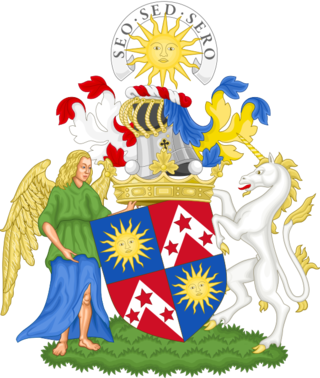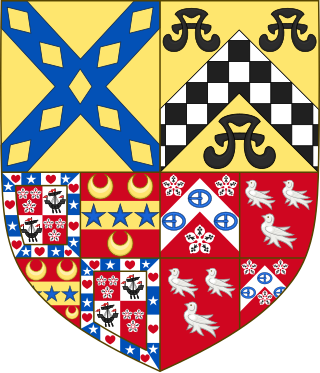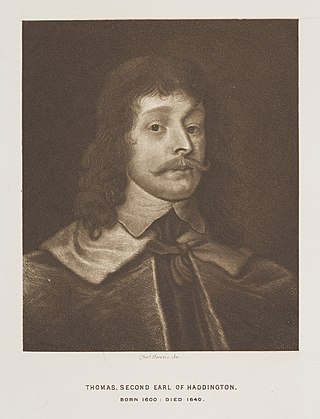Related Research Articles

Marquess of Lothian is a title in the Peerage of Scotland, which was created in 1701 for Robert Kerr, 4th Earl of Lothian. The Marquess of Lothian holds the subsidiary peerages of Earl of Lothian, Earl of Ancram, Viscount of Briene (1701), Lord Newbattle (1591), Lord Jedburgh (1622), Lord Kerr of Newbattle (1631), Lord Kerr of Nisbet, Langnewtoun, and Dolphinstoun (1633), Lord Kerr of Newbattle, Oxnam, Jedburgh, Dolphinstoun and Nisbet (1701), and Baron Ker, of Kersheugh in the County of Roxburgh (1821), all but the last in the Peerage of Scotland. As The Lord Ker in the Peerage of the United Kingdom, previous marquesses sat in the House of Lords before 1963, when Scottish peers first sat in the House of Lords in their own right. The holder of the marquessate is also the Chief of Clan Kerr.

Marquess of Anglesey is a title in the Peerage of the United Kingdom. It was created in 1815 for Henry Paget, 2nd Earl of Uxbridge, a hero of the Battle of Waterloo, second in command to the Duke of Wellington. The Marquess holds the subsidiary titles of Earl of Uxbridge, in the County of Middlesex, in the Peerage of Great Britain (1784), Baron Paget, de Beaudesert, in the Peerage of England (1553). He is also an Irish Baronet, of Plas Newydd in the County of Anglesey and of Mount Bagenall in the County of Louth.

Earl of Home is a title in the Peerage of Scotland. It was created in 1605 for Alexander Home of that Ilk, 6th Lord Home. The Earl of Home holds, among others, the subsidiary titles of Lord Home and Lord Dunglass (1605) in the Peerage of Scotland, and Baron Douglas, of Douglas in the County of Lanark (1875), in the Peerage of the United Kingdom. Various Earls of Home have also claimed the title of Lord Hume of Berwick. The Earl is also Chief of the Name and Arms of Home and heir general to the House of Douglas. The title of Lord Dunglass is used as a courtesy title by the eldest son of the Earl.

Earl of Haddington is a title in the Peerage of Scotland. It was created in 1627 for the noted Scottish lawyer and judge Thomas Hamilton, 1st Earl of Melrose. He was Lord President of the Court of Session from 1616 to 1625. Hamilton had already been created Lord Binning in 1613 and Lord Binning and Byres, in the County of Haddington, and Earl of Melrose, in the County of Roxburgh, in 1619. These titles were also in the Peerage of Scotland. The title of the earldom derived from the fact that he was in possession of much of the lands of the former Melrose Abbey. However, Hamilton was unhappy with this title and wished to replace it with "Haddington". In 1627 he relinquished the earldom of Melrose and was instead created Earl of Haddington, with the precedence of 1619 and with limitation to his heirs male bearing the surname of Hamilton. This derived from the fact that he considered it a greater honour to take his title from a county rather than from an abbey. Hamilton was a member of the prominent Scottish family of that name and descended from John de Hamilton, younger son of Walter de Hamilton, who was granted the feudal barony of Cadzow and who is also the ancestor of the Dukes of Hamilton and Dukes of Abercorn.

Lord Elphinstone is a title in the Peerage of Scotland created by King James IV in 1510.

Earl of Antrim is a title that has been created twice, both times in the Peerage of Ireland and both times for members of the MacDonnell family, originally of Scottish origins.
Archibald John Primrose, 4th Earl of Rosebery,, styled Viscount Primrose until 1814, was a British politician.
Archibald Primrose, 1st Earl of Rosebery PC was a Scottish politician.

Thomas Hamilton, 1st Earl of Haddington, designated before his peerage as 'of Drumcarny, Monkland, and Binning', was a Scottish administrator, Lord Advocate, judge, and Lord Lieutenant of Haddingtonshire.
Charles Cospatrick Archibald Douglas-Home, 13th Earl of Home,, styled Lord Dunglass between 1881 and 1918, was a British peer and banker. He served as Lord Lieutenant of Berwickshire from 1930 to 1951. He was the father of a British prime minister, Sir Alec Douglas-Home.

Alexander Edward Murray, 6th Earl of Dunmore was a British Army officer and peer. He was the son of George Murray, 5th Earl of Dunmore.

Charles Adolphus Murray, 7th Earl of Dunmore VD DL, styled Viscount Fincastle from birth until 1845, was a Scottish peer, Conservative politician, explorer, author, and artist.

William Buller Fullerton Elphinstone, 15th Lord Elphinstone and 1st Baron Elphinstone, known as William Elphinstone until 1861, was a Scottish Conservative politician.

North Hamilton Dalrymple, 9th Earl of Stair was a Scottish aristocrat.

Thomas Hamilton, 2nd Earl of Haddington was a Scottish nobleman.
Alexander Ramey-Home, 10th Earl of Home, styled Lord Dunglass from 1781 to 1786, was a British politician and nobleman. He served as a Scottish representative peer between 1807 and 1841.
Mary Campbell, Countess of Argyll, formerly Lady Mary Stuart, was the wife of Archibald Campbell, 9th Earl of Argyll.
James Alexander Elphinstone, 18th Lord Elphinstone and 4th Baron Elphinstone, AssocRICS, was a British nobleman, farmer, and financier.
Henry James Montagu-Scott, 2nd Baron Montagu of Boughton
Neil Primrose, 3rd Earl of Rosebery KT was a Scottish peer and politician.
References
- ↑ Mosley, Charles, editor. Burke's Peerage, Baronetage & Knightage, 107th edition, 3 volumes. Wilmington, Delaware, U.S.A.: Burke's Peerage (Genealogical Books) Ltd, 2003.